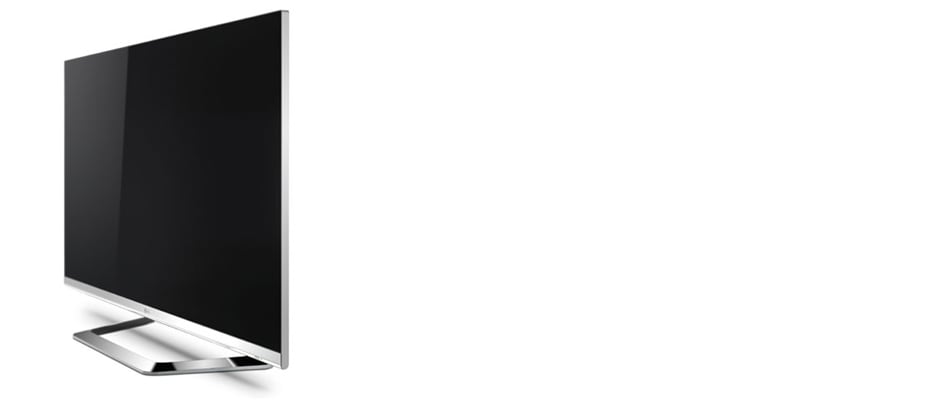Pros
Cons
Introduction
We were ready to deflate the {{product.name}} ($1799 MSRP), a 2012, 1080p, LED, 3D, Smart TV, with our routinely forked tongue, but instead we sat down to a delicious meal of crow. With a new technology that debuted late last year, LG shows us that 3D can look really good, and without most of the problems mentioned above. In addition to opinion-changing 3D images, the {{product.model}} has a newly improved Smart TV menu system, and a remote that makes navigating the ever-expanding sea of content less of an odyssey.
But these extra features are just layers of icing on a cake. Scrape all of this away and you still have a television that needs be tested. We ran our usual battery and the results were certainly appealing. There are a ton of features on this LG, and we cover them all in this review.
Design
This modern panel has futurized written all over it. The sleek silver finish, the bent bar stand, and the monolithic display, and the magic remote mean a whole new style of television. This LG would fit nicely in a house with a modern motif, and it certainly looks cool for now, but in a couple of years, you may rethink this hyper-stylized piece.
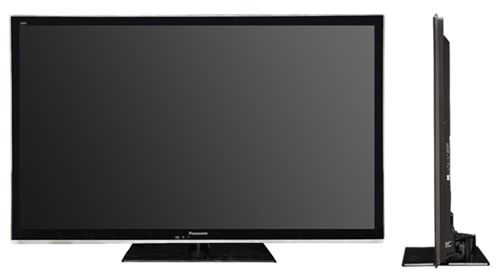
Overall Design
{{section_header}}{{section.name}}{{/section_header}}
We don't think Kirk had a TV this fancy. The {{product.name}} looks like something left over from a Star Trek set, with a magical phaser remote to match. We like what we see here. The extra-styled look captures the fashion of the moment, with a minimal, sleek theme common to modern devices. The display itself is looking sharp. When the screen is off, it appears to be a single piece of blackness, like block of obsidian. The stand is a single, curvy, silver bar that really defines the overall design. This is the one piece that makes us skeptical. Sure, this looks flashy right now, but in two years, will it still have that same punch, or will it look kinda cheesy? Hopefully, when you buy a TV, it's going to last a while. It's not like buying a new shirt, something you can afford to wear a couple of times and switch out for the newest chic. If you are going to wall mount this guy, you will have one handsome display at home.
Front
{{section_header}}{{section.name}}{{/section_header}}

Back
{{section_header}}{{section.name}}{{/section_header}}

Sides
{{section_header}}{{section.name}}{{/section_header}}

Stand/Mount
{{section_header}}{{section.name}}{{/section_header}}
The stand looks cool for now, but we are not so sure it will stand the test of time (that is unless you have this TV long enough for the fashion cycle to come around for another go). There are ways of making a stand different than the usual chunk of black plastic that are not so overly mod. We can see this working really well in a bright, modern, minimal city condo, but not so well in a rustic cabin, or a cultured brownstone. The neck of the stand swivels about 15º in either direction. The movement is nice, but it's not really enough to be helpful. Wall mounting would be our recommendation.
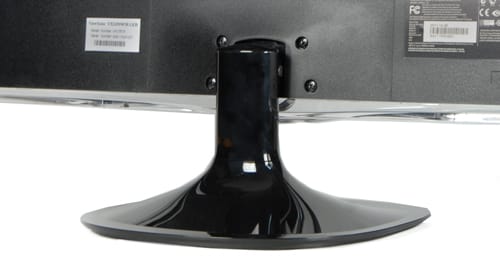
On-set Controls
{{section_header}}{{section.name}}{{/section_header}}
The manual controls are done with physical buttons, rather than touch controls. The buttons are on the right side, behind the front panel. Each one of the buttons has a unique texture, which will help you determine which button you are pressing, without craning your neck to see behind. LG has satisfied all of our usual qualms about manual controls, so there is nothing to complain about here except for the lack of stuff to complain about.

Remote Control
{{section_header}}{{section.name}}{{/section_header}}
LG has done a spectacular job with their new Magic Remote. This radio frequency operated device works very much like a wireless mouse, but it does not require a surface to track. It is not like the Wii remote, where the controller must be pointed exactly at your target. The cursor for this remote is bounded by the edges of the television, such that you can be pointing outside the frame of the television and still be selecting something in the middle. This works well because you can have the remote casually at your side while having command over the entire screen. If at any time you want to reset the area of effect, you can shake the remote back and forth and it will recenter. In addition to the movement, there is a clickable scroll wheel in the center that will make your selections and cruise through options.
Now, why a remote that works like a mouse? The {{product.name}} is of the smartest of TVs out there, with so many options, apps, and online possibilities that being able to fly around the screen and select what you want makes all of these offerings more useful. Usually we say that internet on the TV is worthless because the navigation doesn't make any sense when you only have four directional buttons. This time, you can click on any link you want and enter text with quickness and ease.
Also, because of the mouse-like reflexes of this remote, there only need to be a very few buttons topside. There is the Home button, which opens up into the hub where you can choose everything this TV has to offer. There are the volume and channel buttons, an Apps button and a back button to help you cruise the web.
This remote is revolutionary for the Smart TV market and we like this new direction. We will say that though the functionality is great, it does take a little time to get used to. A few of us felt like the cursor had a mind of its own, or that it was hard to be accurate, but after a little use, it has been the easiest and most functional remote we have used to date.
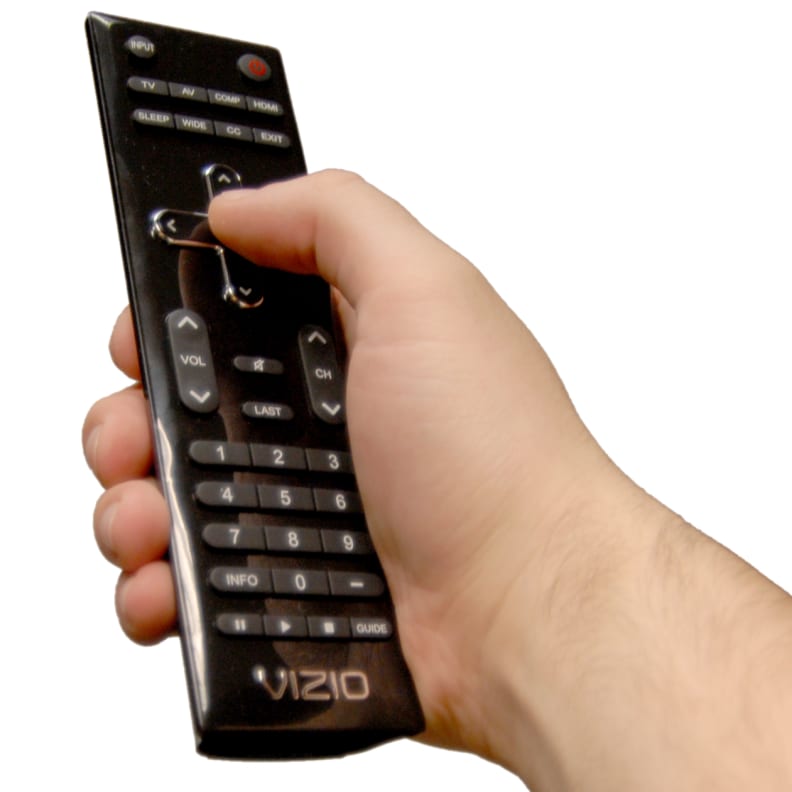
In the Box
{{section_header}}{{section.name}}{{/section_header}}
The box came chalk full of goodies. There is an adapter for the composite/component port, a magical remote with batteries, cable ties, a manual, warning and warranty documents, but most of all, six - count them- six pairs of passive 3D glasses. We know that the total cost to LG was about 45 cents to add these glasses, but the generosity is still appreciated.
Connectivity
{{section_header}}{{section.name}}{{/section_header}}
There are four HDMI ports and three USB ports on the back left side of this display in an L-shaped cutout. What could you possibly do with three USB ports you ask? Well, there is one USB port for transferring Apps to and from this LG, another for connecting an external hard drive full of your playable content, and yet another for connecting a USB hub so you can connect as many USB devices as you like: infinite USB ports! Two of the HDMI ports have specific functions as well. One of them is the HD ARC (Audio Return Channel) connection which allows for audio transfer between sources, essentially acting as simultaneous HD video and SPDIF connection. There is another HDMI port specifically labled for a PC connection, but we are not sure what the difference between this HD port and any other would be for connecting an HD signal from a computer, but whatever.
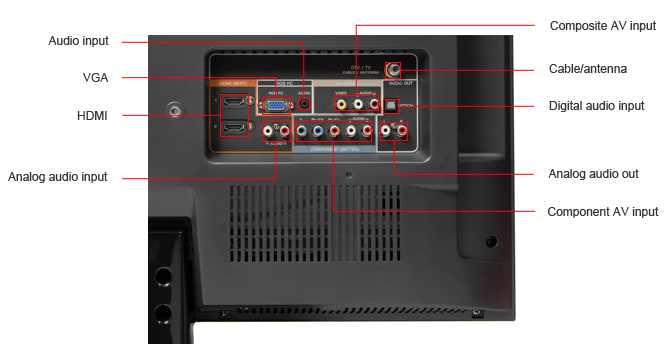
In addition to these more modern connections, there is a LAN port, a VGA plug, an RF antenna, and an adapted composite/component connector. The adapted component port is the only analog connection on this TV. We understand that these ports are going the way of the ice caps, but there are still devices, new and old, that use the component plug. Make sure you do not have such devices or that you are willing to replace them if you buy this TV.
With a swivel stand, these ports are easy to access on the left side behind the panel. The arrangement is cleverly done, putting all of the HDMI ports together in one easy-to-reach section. Well played LG.
Connectivity Comparison
{{ attachments(5123ac2f6c477e3eca000843)
Other Models in the Series
For more information on other models in this series, check our Series Comparison Page.
{{ attachments(5123ac4be0d94aaf8a000848)
Performance
If we judged this TV solely on it's performance, we would say it's great. LG is repeating its usual strengths and weaknesses. The {{product.model}}, showcases some of the best color accuracy in the business, and a surprisingly low contrast ratio. Using black levels way brighter than other top-quality displays, LG still maintains quality without competing in one of the leading stats. You may not see any rich dark values, but the colors, as usual, are fantastically accurate. On top of this, the viewing angle is spectacular for an LCD screen, and the motion processing was pleasantly rendered.
Contrast
{{section_header}}{{section.name}}{{/section_header}}
We recorded a surprisingly low contrast ratio coming out of this LG. The black level is very bright for such a high-end television. You can see that it does not compare to similar models in our contrast chart below. Even so, a contrast ratio over 1000:1 is good, it's just not what we expect from such a large price tag. More on how we test contrast.
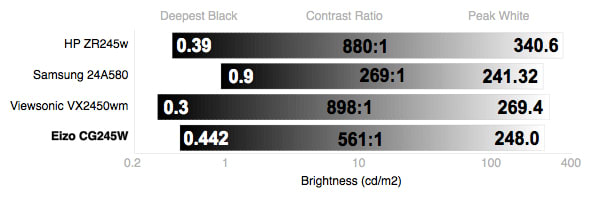
Color & Greyscale Curves
{{section_header}}{{section.name}}{{/section_header}}
These color curves are looking good like they should. All three primary colors and the grayscale graphs are in line with each other, as smooth as glass and have a nice even curve to them. This shape and consistency means that all colors and gray values have excellent detail from one shade to another. More detail means a more believable picture, a more immersive experience.
Detracting from the a perfect score here is the flat segment of the line that starts at the left side and reaches significantly into the gray values. This means that from dark gray to black, all pictures will have zero luminance, appearing to be completely black. The darkest values will not have the excellent detail that the rest of the spectrum profits from, instead it will be wholly black without differentiation. More on how we test color performance.
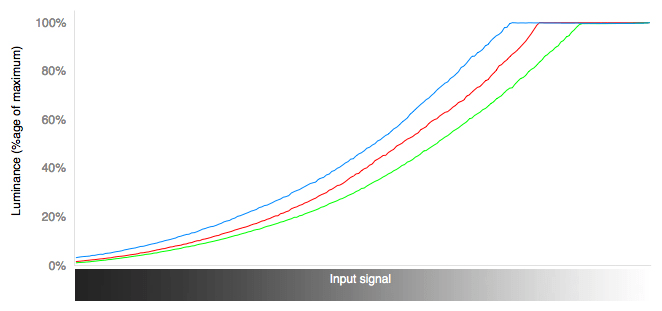
Color Temperature
{{section_header}}{{section.name}}{{/section_header}}
The color temperature proved to be very accurate throughout the spectrum from light to dark. There were some minor errors, but nothing so severe. More on how we test color temperature.
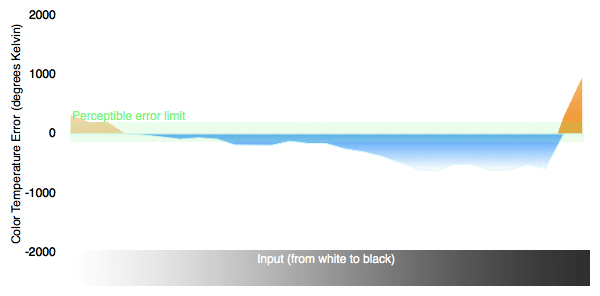
Color Gamut
{{section_header}}{{section.name}}{{/section_header}}
Pictured here, in the chart below, are the colors produced by the {{product.name}} matched against the international standard for HDTV colors called the Rec. 709. You can see that the match is, for the most part, very strong. The blue and the red values showed the biggest errors in relation to the Rec. 709, both of them testing to be undersaturated slightly. More on how we test color temperature.
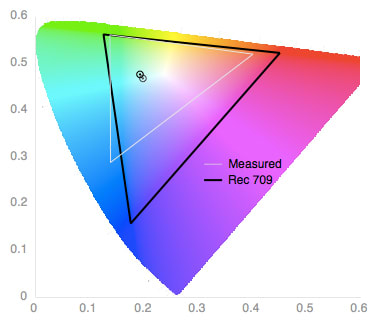
Picture Dynamics
{{section_header}}{{section.name}}{{/section_header}}
We test all of our screens for picture dynamics by showing different areas of black and white on the screen, while testing the luminance at the center. We are looking to see if the peak brightness or the black level change depending on the images shown on the screen. If this is true, we can conclude that the contrast ratio is as great of a range as it may claim to be, because you will never see the darkest dark against the brightest bright on the same screen if the levels change dynamically. The high score earned by the {{product.model}} in this test shows that the peak brightness and the black level remain steady, no matter what is shown on the screen. More on how we test picture dynamics.
Resolution & Formats
{{section_header}}{{section.name}}{{/section_header}}
The {{product.name}} is a 1080p display and supports all ATSC and NTSC content.
Viewing Angle
{{section_header}}{{section.name}}{{/section_header}}
The viewing angle on this LCD screen is rather wide. It won't compare to a plasma model, but more than 30º of strong picture viewing is pretty good. We noticed that the black level dropped off center, thus preserving a really strong contrast ratio through this whole range.
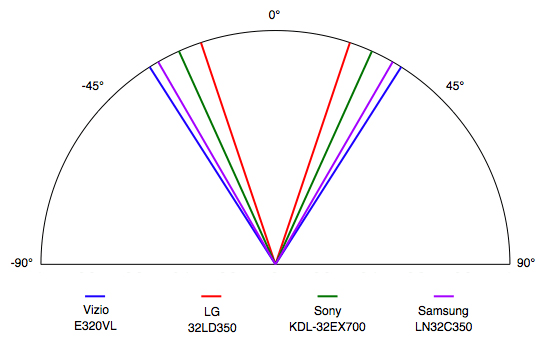
Motion Performance
{{section_header}}{{section.name}}{{/section_header}}
Though the {{product.name}} uses a TruMotion 120Hz motion processing feature, we could not find any way to turn it on/off or adjust it in any way. There was no mention of it in the menu, the manual, or the on-board TV user guide. If it is on, TruMotion does not seem to be a motion interpolation mode because film based content looks great. There is no Soap Opera effect as far as we can tell, and visual observation is the only thing that really matters.
Regardless, the {{product.model}} performed adamantly in our motion tests. We saw very few jagged lines on moving objects and no shape distortion. Bright colors trailed slightly, leaving trace images of previous frames, but the intensity of the trails was low. Detail retention was good as well. Faces became slightly blurry, but were still recognizable, and high density detail was well retained.
{{product.manufacturer_specs['Motion Performance Image']}}
Screen Uniformity
{{section_header}}{{section.name}}{{/section_header}}
An all-black screen showed only minor flashlighting of the backlighting elements in the corners, but overall was smooth and dark.
{{product.manufacturer_specs['Screen Uniformity Image']}}
Audio Quality
{{section_header}}{{section.name}}{{/section_header}}
We are not sure exactly what LG is doing with these 10W speakers to make them sound so good, but we were impressed with the quality and the overall volume. There is a simulated surround mode that we tested. This mode definitely ads depth to the sound coming from the screen, objects in the background sound as though they are further away from those in the foreground, but this interesting feature also detracted from the quality we observed without the surround mode. We liked what we heard without the surround mode on, our recommendation is to keep it off. But really our main recommendation is to treat yourself to some external speakers and blow your house down with supreme sound power.
Power Consumption
{{section_header}}{{section.name}}{{/section_header}}
Of all the comparison models we chose, the {{product.name}} uses the least amount of power. A little more than $10 per year is great for such a large television with advanced features. Sometimes we see a 32-incher using this many watts when it cannot even connect to the internet. The {{product.name}} shows us repeatedly that it is a good investment all around.
{{ attachments(5123bacd45317f99c6000334)
Average Cost Per Year
{{ attachments(5123bae16450af791900080d)
Other Models in the Series
For more information on other models in this series, check our Series Comparison Page.
{{ attachments(5123ac4be0d94aaf8a000848)
Calibration
{{section_header}}{{section.name}}{{/section_header}}
We started with the first ISF Expert calibrated mode and adjusted from there. ISF calibration is one of the two leading calibration companies, the other is THX. This calibration was very close to our final calibration. The main difference is we jack the backlight up so that you can watch the television in any lighting setting. Turning the backlight up has no effect on the quality as it adjusts all values linearly, thus preserving all gamma curves and the contrast ratio. You can see our calibration numbers in the table below.
{{ attachments(50fc3ecbbd0286d5550af48a) All of our calibration is done in conjunction with the DisplayMate software.
Video Modes
{{section_header}}{{section.name}}{{/section_header}}
There are a handful of video modes on the {{product.name}}. We were impressed by two different ISF Expert calibrations, ISF 1 being very close to the calibration we finished with.
{{ attachments(5123bd40caf50f83d200044e)
Other Models in the Series
For more information on other models in this series, check our Series Comparison Page.
{{ attachments(5123ac4be0d94aaf8a000848)
3D
LG is doing something revolutionary here. Starting in the 3rd quarter of 2011, LG has circularly polarized the light coming out of their televisions to create the illusion of 3D images. An explanation of circular polarization can get as complicated as you would like, requiring some very high level science. As a simplification, circularly polarized light is really two identical light waves, the height and depth of the waves arranged at 90º angles to each other. One wave is setup a quarter phase off of the other; slightly delayed. If you observed these light waves from straight on, you would perceive the light to be traveling in a circular motion.

These light waves can be "right-handed" or "left-handed", meaning that they appear to travel in a clockwise or counter-clockwise manner. The screen on new 3D LGs, such as the {{product.model}}, comes equipped with a layer called a quarter-wave plate, a filter that adjusts the phase of the two light waves so that they match again. Once matched, the quarter-wave plate takes a vector average of the waves and outputs a singular light wave, one that emits at a 45º angle. The direction of this angle is determined by which light wave hits first. So, if you have left-handed and right-handed circularly polarized waves, these will come through the quarter wave plate as 45º and 135º, linear, light waves.
Once you have light emitting linearly at predictable angles, you can use polarized filters in the lenses of the 3D glasses to block one of the angled light waves from one of the eyes. Thus, you can have two offset pictures, each emitting at different angles and being perfectly polarized to either the left or the right lens. Your brain will combine the two perfectly separated images into a 3D image, that we have to say, looks really good.
Sure this is new, but why is it better? It improves on the disadvantages of all previous technology, both passive and active. Active shutter technology requires that you only see a left-eye or right-eye image at any given time. Furthermore, there are moments of total darkness where nothing is seen, to facilitate the combination of the rapidly flickering and alternating images seen through the glasses. The result is that you lose more than half of the refresh rate of your screen, and motion will look shaky. The 3D comes at full HD, but you see more nothing than you see picture.

Our biggest gripe with this method was the constant flickering though. The flashing in your eyes is one of leading causes of brain strain, eye, and head aches. The technology also requires heavy, expensive equipment. It is hard to watch a feature length film with clunky eye wear and constant flashing right in front of your eyes. Did we mention that these expensive glasses still suffered from heavy crosstalk as well? Some of the worst crosstalk numbers (the percentage of a right eye image that ended up in the left eye) were recorded on the active shutter lenses.
We felt that passive lenses were an improvement on active shutter glasses because they did not flicker, but passive technology (until now) had it's own set of drawbacks. Before circular polarization of light was employed, passive 3D televisions used the same 135º and 45º angles and polarized lenses to make 3D images. However, to achieve these angles, the screen was divided into a a crisscross pattern. It was hard to see with the eye, but every other line of pixels was removed to show a directional picture that could be filtered by polarized glasses. Removing every other line of pixels means a halving of the resolution. No longer can you see 1080p 3D images, the best you can hope for is something slightly better than standard definition. If you turned your head one way or the other, the polarization did not work because the angles were incorrect, and the 3D illusion would be ruined. Any amount of angle to your head would cause severe crosstalk because the angles for the wrong eye would creep into the glasses. Unless you wanted to watch your 3D TV with a protractor taped to your head, the image quality would not be worthy of the investment.
LG's new circularly polarized images and Film Patterned Retarder (FPR) lenses combine to remove all of these disadvantages. There is no resolution loss, because pixels do not need to be cutout to make the angles for polarization, meaning you can watch 1080p 3D images. There is no flickering, and therefore no refresh rate loss. Due to the circular nature of the light waves, you can still see 3D images with your head off-angle (as a side note, the vertical angle is not very good. We recommend keeping your eye-level at the vertical center of the display). The crosstalk numbers are far and away the best we have ever seen, proving to be an extremely noticeable improvement when watching actual 3D content. The glasses are light and inexpensive, as well as fashionable. LG is working with designers to make combined UV/Polarized sunglasses that work with their 3D displays.
A final note worth mentioning is the area of depth LG has chosen. Often, we see 3D images using only the area in front of the television. We noticed that without the glasses, there is an area of the depth where the 3D images are not offset, the images are very clear, and look just like watching 2D television. This is because the plane of the television represents the middle depth of the 3D illusion. The foreground extends out the front of the television, and the background receeds into the television, with the TV itself used as midground. This is important because The Journal of Vision produced a paper about the dangers of 3D images and how they certainly produce eye strain. Their findings show that eye strain occurs because we are forcing our eyes to focus on two planes simultaneously: the plane of the television emitting the light we see, and the false plane of the 3D image. If LG is employing the plane of the television as the middle ground, then often your eyes are focusing only on one plane, while still experiencing 3D images. This should by all reasoning reduce eye strain and other possible dangers associated with 3D imaging.
Overall, this is the best 3D technology we have seen. We really like the images, they are mesmerizing and fun to watch. It does not get tiring, it is not sickening, or exhausting, it's just 3D, the way you have always pictured it to work.
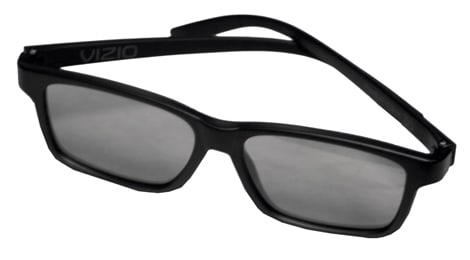
3D Effect & Experience
{{section_header}}{{section.name}}{{/section_header}}
The LG Cinema 3D creates a truly immersive experience. We immediately noticed a difference between last year's product and this new generation. Even the stalwarts among us were persuaded to say that this new 3D is worth watching. Such acceptance is unheralded here at Televisioninfo.com; a huge compliment and a strong endorsement of LG's work here. We are not the only ones to think so, as the International 3D Society gave LG an award this January for advancing the industry with LG Cinema 3D.
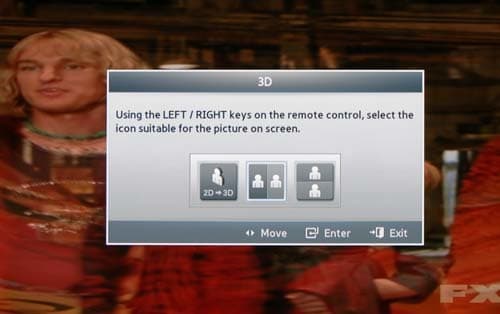
Some of the options in the 3D menu
The glasses are the kind you get at the theaters. These passive FPR glasses are super light and unobtrusive. LG was kind enough to put six pairs of these glasses in the box. They don't cost much, but they also could have forced the consumer to buy more at about $10 each.
These glasses still don't look the definition of chic. That could change too though. LG is planning to work with designers of sunglasses to make UV protected, FPR glasses that will work outside and as 3D lenses.
For now, these spectacles are light, they work, and they do not look awful.
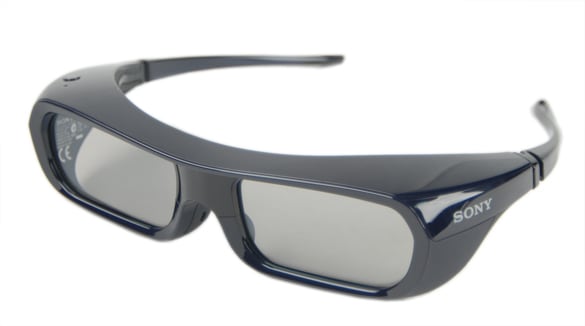
Yes, you will look like a dork with these on
3D Contrast
{{section_header}}{{section.name}}{{/section_header}}
Though the FPR lenses are not too dark, they did diminish the peak brightness. Somehow, the black level also increased by a couple of important points. The contrast ratio as usual, is hacked to a fraction of the 2D range.

3D Color
{{section_header}}{{section.name}}{{/section_header}}
Televisions often show errors in color temperature when in 3D. The {{product.name}} did well here, maintaining a consistent color temperature throughout the brightness spectrum, with only minor errors.
These curves are showing some severe errors. We often see a drastically different color output in 3D than we do in 2D, but we did not expect it here. Considering the technology does not change the picture quality, merely it doubles up.
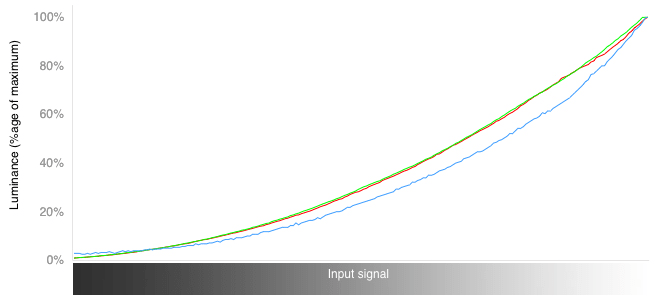
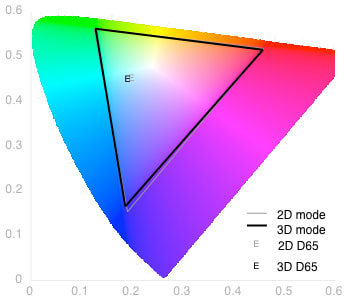
3D Crosstalk
{{section_header}}{{section.name}}{{/section_header}}
The {{product.name}} showed the fewest crosstalk errors of any 3D television we have ever tested, and the improvement was noticeable as well. Whenever part of an image intended for the right eye ends up in the left eye, this is called crosstalk. Crosstalk significantly reduces the 3D illusion because your brain is no longer combining two separate images, but ghosted half images. We use scenes with high contrast, which are the hardest to reduce crosstalk. Often, we would see haloed ghost images around white objects on a black background, but there was nothing of the sort on this LG. We saw no haloing at all, and our numbers back this impression up.
Software & Internet
Browser
Apps
{{section_header}}{{section.name}}{{/section_header}}
What a load of App! Actually, using Apps on this LG makes the most sense of any television we have reviewed so far. You can add Apps to the Home page or along the Apps bar, which will appear on the bottom of the screen when you press the My Apps button on the remote.
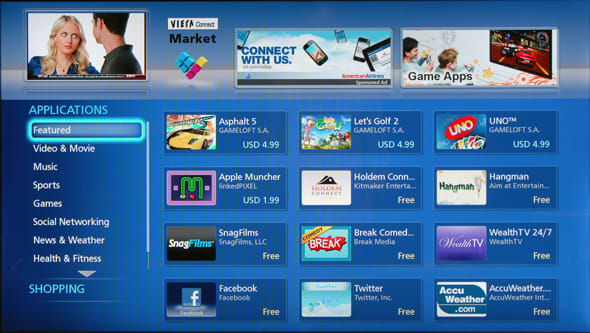
To purchase Apps, you may simply click on the LG Smart World button in the Home screen. The organization of the store allows you to filter Apps by cost, genre, and recent buzz.
If you want to check the weather, get updates on the entire NBA, see NY Times headlines, or really whatever, there's an App that will perform said function. Apps may be a speedier way of getting information from the internet, given the graphically based, rather than textually based, interface.
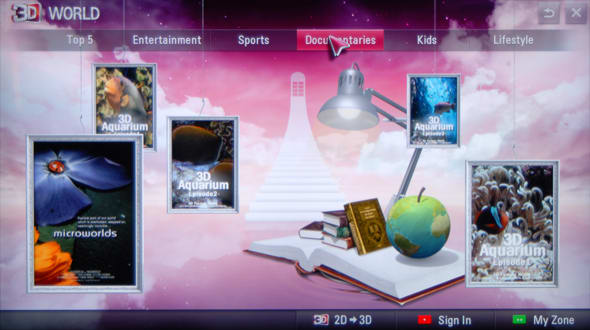
LG 3D world has more streaming 3D content by the day.
LG has some unique Apps that we think add to the smart TV experience. The LG 3D World App is a center for streaming online content, filmed and produced in 3D, on a wide range of subjects. Even if you do not have a 3D BluRay player, LG 3D World will submerge you in so much 3D it will make your eyes bleed (figuratively. If your eyes actually start to bleed, contact a physician....at your leisure).
There is also the LG Social Center, a way to monitor your Facebook and Twitter feeds while you watch TV simultaneously. The interface is simple, allowing you to switch back and forth between the two social media sites by clicking two small icons near the top of the page. The integration of television and social media is something that companies really want to get going (for many reasons, including boosting the importance all of their products for free by having people gab about them online) and LG's simple interface helps this trend right along.
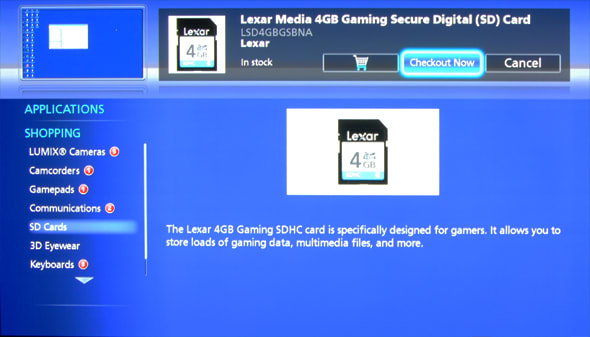
Other Internet Features
{{section_header}}{{section.name}}{{/section_header}}
The LG Smart Share feature is another great little tool. If you have content on your tablet, phone, or other device, you can pop it up on the TV provided you are connected to the same wireless network. LG Smart Share can be accessed by the Apps bar on the bottom. As soon as you list your device, the {{product.model}} will search for usable media and display it in a clickable list.
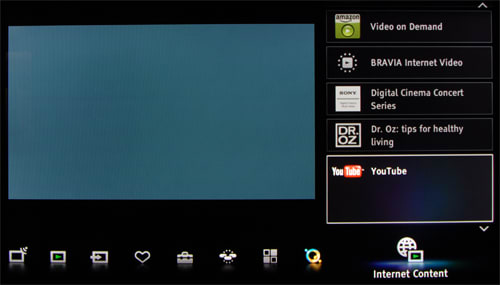
Other Media
{{section_header}}{{section.name}}{{/section_header}}
Don't count out the USB media port! The USB media interface on this LG is quite intuitive. Sifting through photos and selecting the ones you want for a slideshow is quick and easy with the scroll wheel and the point-and-click nature of the remote.

Photos, videos, and music are not separated into their component categories, a segregation we never understood. Instead, the {{product.model}} allows you to select whatever is on the media drive and play it regardless of the type of content. We had no problems playing any of our various files. There are options to add music to slideshows, and ways to control the transition speed and type. It's a super easy way to look at photos from a camera, or to share a video you carry around on a USB port.

Other Models in the Series
For more information on other models in this series, check our Series Comparison Page.
{{ attachments(5123ac4be0d94aaf8a000848)
Menu Interface
{{section_header}}{{section.name}}{{/section_header}}
The Home menu collects all of the LG smart features in one area, as well as the picture settings, and the input list. If you need anything, the Home menu has it, arranged in an easy to navigate format. There are "cards" in the Home menu. When you turn it on from the factory, there are three of these cards. One holds the premium streaming content, one has the LG 3D world content, and the other is filled out with the LG Smart Share features. Other than the premium content, these cards are completely customizable. You can remove or add a card and change what appears there. You can add any one of the built-in features to a card, as well as any Apps you download from the store.
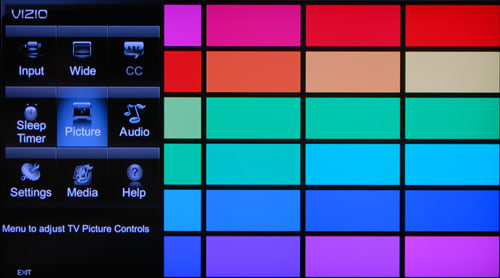
The settings menu looks much like the menus of old, but you will navigate it with the magic remote. These two clash a little, as the scroll wheel does not work here, and whipping around with the remote will switch menus rapidly, but with some patience, the two will get along.
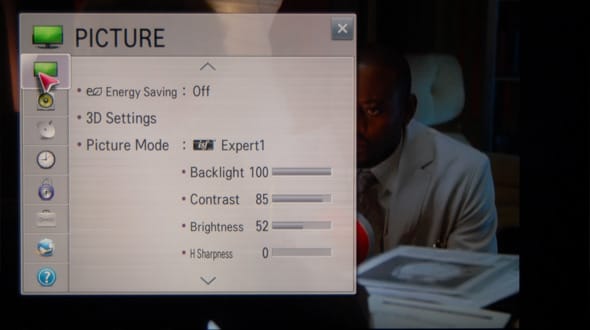
The 3D menu is best left alone. When the {{product.model}} detects 3D content, it will switch right over. Adjusting the 3D seems to derange the effect and we found it easiest to have the LG do the work.
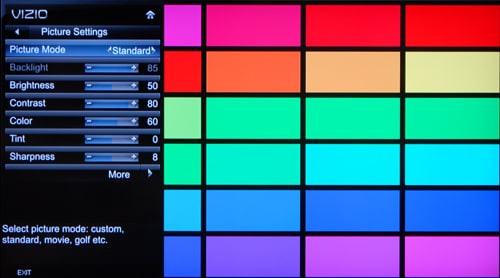
Other Interface Features
{{section_header}}{{section.name}}{{/section_header}}
One of our favorite features is the search function, accessible from the Home menu. This function searches the entire realm of smart TV possibility for what you want. If you type in a show title, it will let you know exactly all the thousands of ways you can watch that show, immediately. If it's available on Netflix, Hulu, Vudu, from your media port, on LG Smart Share, or any other possible way, it will be listed here. We were surprised by how thoroughly and quickly the search worked. If the search comes up with nothing, which is doubtful, be assured that you won't be able to get instant access to the content anywhere else.

Instruction Manual
{{section_header}}{{section.name}}{{/section_header}}
There are two instruction manuals for the {{product.name}}, and both are a little disappointing. The paper manual is spare, covering basic setup, connectivity, the remote, and troubleshooting. We figured that the finer details, the nitty-gritty, would be covered in the user manual inside the TV.

When we got there, we could not find simple items, like the motion processing features or explanations of various settings. Rather, there were lengthy descriptions of new features. This is certainly helpful, as the LG Dual Play will require an in-depth explanation, but when basic information is not available, we get a little peeved. You can find a digital copy of the User Manual here.
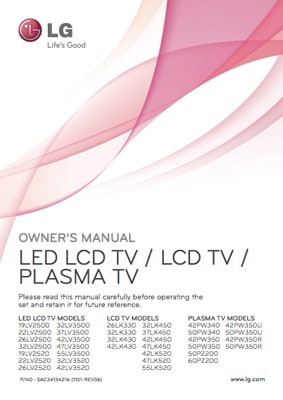
A manual for so many TV models, they have to be further categorized by type.
Other Models in the Series
For more information on other models in this series, check our Series Comparison Page.
{{ attachments(5123ac4be0d94aaf8a000848)
Value Comparison
{{section_header}}{{section.name}}{{/section_header}}
We matched the {{product.name}} up with a similar 3D LG TV from last year, the LG 47LW5600. They are definitely comparable in the stats, but the {{product.model}} has better color production, and a wider viewing angle. But the biggest improvements over 2011's great television are definitely upgrades. The online content has better organization, the improved magic remote makes the streaming content all the more accessible, and the 3D images set the standard of quality. It's really a no-brainer, the {{product.name}} is definitely an improved display.
{{ attachments(5123c2fffabe1d0326000010)
Blacks & Whites
{{section_header}}{{section.name}}{{/section_header}}
Even with a deeper black level, the {{product.model}} does not have a better contrast ratio than the much brighter 47LW5600.

Color Accuracy
{{section_header}}{{section.name}}{{/section_header}}
The {{product.model}} from this year has a more accurate color gamut and is capable of greater detail rendering. We think this color advantage is a huge boon to this newer LG.
{{ attachments(5123c4028ed2fa0e2d000899)
{{ attachments(5123c41a5601fb6c70000961)
3D
{{section_header}}{{section.name}}{{/section_header}}
No contest here. The {{product.model}} produces the best 3D images we have ever seen. Last year was so last year.

Yes, you will look like a dork with these on
{{ attachments(5123c58a63f5384c8000098e)
{{ attachments(5123c5655601fb6c7000096a)
Screen Performance
{{section_header}}{{section.name}}{{/section_header}}
This years {{product.model}} has a wider viewing angle and some really good looking motion performance, outstripping last year's model.
{{ attachments(50fd0d3cbd0286de7b01b2e6)
Connectivity
{{section_header}}{{section.name}}{{/section_header}}
The connection options on both of these upper-level LGs look very similar. The {{product.model}} from 2012 has more versatile USB ports, allowing for App transfers and hard drive connections.
{{ attachments(5123ac2f6c477e3eca000843)
Value Comparison
{{section_header}}{{section.name}}{{/section_header}}
For about the same price, you are looking at two very similar televisions, both in terms of high-end performance and a laundry list of features. The biggest performance trade-off is the {{product.name}} showed us better colors, while the Samsung UN46D6500 had a much stronger contrast ratio. They have the same number and type of ports, they both can connect to the internet, but the 3D on the {{product.name}} is the best out there. We have not yet gotten our hands on a 2012 Samsung to be able to compare the smart TV interface between LG and Samsung, but this LG has done it right with a well-organized layout of options, and a magic remote to navigate it all smoothly. Comparing this year's LG to last year's Samsung, we think the LG gives consumers a better value.
Blacks & Whites
{{section_header}}{{section.name}}{{/section_header}}
Without a stunning black level, the {{product.name}} cannot compete with these other high-end televisions in our contrast comparison.

Color Accuracy
{{section_header}}{{section.name}}{{/section_header}}
Maybe it does not have the best contrast ratio, but the colors are hard to beat. The {{product.name}} showed us more accurate colors than the Samsung UN46D6500 in every one of our tests.
3D
{{section_header}}{{section.name}}{{/section_header}}
Not a single 3D technology we have tested was good enough for our enjoyment until the {{product.name}}. This statement includes the Samsung UN46D6500, which uses flickery, expensive, active glasses to produce stereoscopy. Samsung should be taking notes. LG has taken the lead in the 3D game.

Yes, you will look like a dork with these on
Screen Performance
{{section_header}}{{section.name}}{{/section_header}}
The viewing angle on the {{product.name}} was impressively wide for an LCD screen, wider than that of the Samsung UN46D6500. The motion processing was about the same, but the {{product.name}} achieved a similar score without motion processing modes that make film based content look cheap. With the motion processing disabled, the Samsung UN46D6500 will not match up to the {{product.name}} here, and we recommend turning off motion processing on all of our TVs.
Connectivity
{{section_header}}{{section.name}}{{/section_header}}
These two TVs have almost the exact same ports layout, with three USB ports of differing capability, four HDMI ports, a single adapted component port and internet connectivity.
Other Comparisons
{{section_header}}{{section.name}}{{/section_header}}
Samsung's Smart Hub lead the pack of last years smart televisions in its simplicity and all-encompassing format. LG seems to have learned a lesson from Samsung and produced a very similar front page called the Home menu. We think both are equally helpful, but it is hard to say that LG is better than Samsung, as we have yet to get our hands on a 2012 Samsung model, which will have updated online content.
Value Comparison
{{section_header}}{{section.name}}{{/section_header}}
The reason you would pay so much money for one of these televisions is the 3D imaging and the smart TV functions. Otherwise, you could just buy a cheaper Sony or LG and get similarly excellent screen performance. The {{product.name}} has 3D images that we challenge other manufacturers to best, the Home menu and a magic remote that make smart TV offerings useful and easy. Go with the LG on this one.
Blacks & Whites
{{section_header}}{{section.name}}{{/section_header}}
Contrast really is all about the black level, and the {{product.name}} couldn't produce very deep blacks. As a result, the Sony KDL-46HX729 has a much better contrast ratio.

Color Accuracy
{{section_header}}{{section.name}}{{/section_header}}
Both of these screens have excellent color fidelity. The {{product.name}} showed us some better detail and consistency when transitioning from one value to another along the spectrum from darkest to brightest, but the Sony KDL-46HX729 had a more accurate color gamut and fewer color temperature errors.
3D
{{section_header}}{{section.name}}{{/section_header}}
Though this second generation active shutter Sony 3D display was a huge improvement over the previous year, it is nothing quite so good as what we saw on the {{product.name}}. We have not liked a 3D TV until now, and this LG really sets the standard for what we will accept.

Yes, you will look like a dork with these on
Screen Performance
{{section_header}}{{section.name}}{{/section_header}}
The {{product.name}} has one of the widest viewing angles for an LCD model we have ever tested, while the Sony KDL-46HX729 is merely average here.
Motion handling on the {{product.name}} was impressive for a couple of reasons. The screen refreshes at 120Hz natively, meaning that it does not improve the motion processing by interpolating frames. Motion interpolation does add smoothness and reduces artifacts of moving objects, but it also makes film content look really cheap. We did not notice this cheapening when watching content, something we definitely saw when the motion processing features were turned on with the Sony KDL-46HX729. It's hard to say which one is more affective. With the motion interpolation, the Sony scored better in our tests, but for most viewing situations, we suggest that you turn these modes off, in which case the {{product.name}} will be a better bet.
Connectivity
{{section_header}}{{section.name}}{{/section_header}}
The number of ports is about the same on both of these TVs, but we like the clever arrangement on the LG better. All of the HD and digital ports are located on an easy-to-reach side cutout, and the others arranged along the bottom. On the Sony, the ports are mixed together and scattered about in two areas.
Other Comparisons
{{section_header}}{{section.name}}{{/section_header}}
Sony had a hard time managing the variety of functions that come with a smart TV. They set up too many menus, added too many frivolous apps, and couldn't quite put them all in one place. The complexity of the menus and the separation of similar items made navigating the Sony smart TV interface a chore. The {{product.model}} improved on the LG's excellent interface from last year with the Home menu. This one page hub collects all of the functions in one area, in a layout that is super simple.
Conclusion
{{product.vanity}}
The {{product.model}} ($1799 MSRP) is a spectacular 3D smart TV from LG, debuting in 2012. This 1080p display has a native refresh rate of 120Hz, excellent colors, a magic remote, and the best 3D images on the market.
There is so much to say in favor of this LG. To begin, the picture quality is superb. LG has made sure to take care of the picture essentials before heaping on some of the best advanced features in the industry. The smart TV offerings, like streaming videos, an internet browser, and various apps make up the forefront of the Home menu, where these various features are collected in one helpful interface. The magic remote replaces the old-fashioned, and highly limited, remote control of yore, working intuitively like a computer's mouse. This new remote allows for quick navigation through the hordes of streaming options and makes typing letters into the keyboard for URLs and other searches quick and realistic.
Then, there's the award-winning LG Cinema 3D, which blows all other 3D TVs out of the water as far as we're concerned. The passive 3D images come at viewers in full HD, do not flicker like active 3D, and show so little crosstalk we could hardly believe it. The stunning quality and comfort of the 3D images confirmed all of our testing numbers. This is one 3D display we strongly endorse.
The biggest drawback of the {{product.model}} is the black level. With such a bright black level, the contrast ratio suffered. You can see in our contrast charts that all of our high-end comparison models from last year have a much larger range of black and white values available to create a realistic picture. Oftentimes, black level and contrast ratio are considered the most important attribute of a television, which could be reason alone for well-informed consumers to look elsewhere for their new, multi-function panel.
All together, we support the {{product.name}}. The overall picture quality is fantastic, and the advanced features are top-notch. Honestly, we do not expect to be able to buy a 47-inch TV with this kind of quality and feature set for the money that LG asks. We think any consumer looking for a new-age television will be happy with the {{product.name}}.
Model Series Comparison
{{section_header}}{{section.name}}{{/section_header}}
The xxLM6700 series comprises two 1080p smart televisions, with 3D imaging, internet connectivity, 120Hz TruMotion technology, and magic motion remotes.
{{ attachments(5123e4e567d2485e040009d5)
Photo Gallery
{{photo_gallery "Design Landing Page Photo", "Front Tour Image", "Back Tour Image", "Sides Tour Image", "Connectivity Tour Image 1", "Connectivity Tour Image 2", "Stand Photo", "Controls Photo", "Remote Control Photo", "3D Landing Page Photo", "3D Menu Photo", "3D Glasses Photo", "Connectivity Extra Photo", "Software and Internet Landing Page Photo", "Menu Main Photo", "Menu 2 Photo", "Instruction Manual Photo", "Internet Features 1 Photo", "Internet Features 2 Photo", "Internet Features 3 Photo", "Local Media Playback 1 Photo", "Local Media Playback 2 Photo", "Browser 1 Photo", "Browser 2 Photo", "Browser 3 Photo", "Apps 1 Photo", "Apps 2 Photo", "Apps 3 Photo"}}
Ratings & Specs
{{manufacturer_specs_table}}
Meet the tester
Christian Sherden is a valued contributor to the Reviewed.com family of sites.
Checking our work.
Our team is here to help you buy the best stuff and love what you own. Our writers, editors, and experts obsess over the products we cover to make sure you're confident and satisfied. Have a different opinion about something we recommend? Email us and we'll compare notes.
Shoot us an email